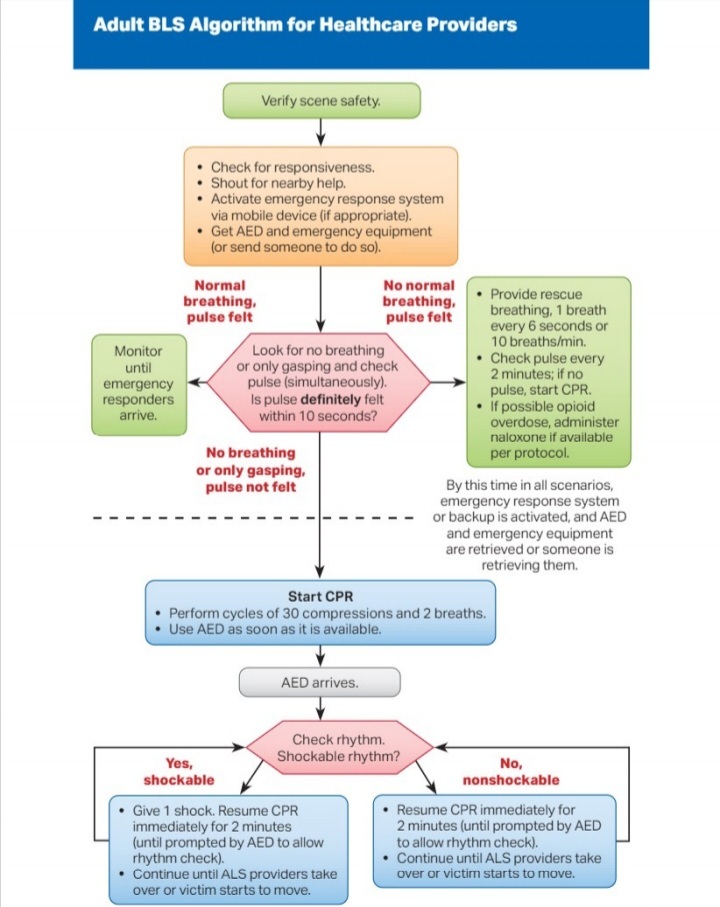(Images can be enlarged if needed)

Cardiac arrest, also known as Sudden Cardiac Arrest, is when the heart stops beating suddenly. The lack of blood flow to the brain and other organs can cause a person to lose consciousness, become disabled or die if not treated immediately.
The terms ‘heart attack’ and ‘cardiac arrest’ are often used interchangeably, but these are two different heart conditions.
A heart attack occurs when there is a blockage in the arteries that stops blood flow in the heart. Due to the lack of blood and oxygen flowing in the heart, the heart muscle tissue will become damaged. Heart attacks can increase the risk for cardiac arrest because heart attacks can alter electrical signals in the heart.
CPR – or Cardiopulmonary Resuscitation – is an emergency lifesaving procedure performed when the heart stops beating. Immediate CPR can double or triple chances of survival after cardiac arrest.
If someone experiences cardiac arrest, they need immediate treatment to increase the flow of oxygen-rich blood to their organs. CPR is the compression over the chest to manually pump a patients heart. Rescue breaths are preformed to provide oxygen to the body.
During CPR, proper hand placement on the lower half of the sternum is crucial. Placing hands over the sternum ensures effective chest compressions directly above the heart, optimizing blood circulation throughout the body.
According to the American Heart Association (AHA), the overall survival rate for out-of-hospital cardiac arrest is around 10%. However, survival rates can be improved if bystander CPR is started immediately. Studies have shown that bystander CPR increases the chances of survival for someone experiencing cardiac arrest. In fact, the AHA reports that survival rates increases to 40% or higher when bystander CPR is performed promptly. The surival rate is between 24% and 40% for those that happen in the hospital, according to the report published online in the Emergency Medicine Journal.
CPR is preformed between 100 - 120 beats per minute. Famously Staying Alive by the Bee Gees is the same beat. A large list of songs with the correct BPM can be found here
![]() The American Red Cross gives the following list of steps to asses if CPR is needed and how to preform:
The American Red Cross gives the following list of steps to asses if CPR is needed and how to preform:
1 CHECK the scene for safety, form an initial impression and use personal protective equipment (PPE)
2 If the person appears unresponsive, CHECK for responsiveness, breathing, life-threatening bleeding or other life-threatening conditions using shout-tap-shout
3 If the person does not respond and is not breathing or only gasping, CALL 9-1-1 and get equipment, or tell someone to do so
4 Kneel beside the person. Place the person on their back on a firm, flat surface
5 The American Red Cross CPR guidelines recommend 100 to 120 chest compressions per minute, 30 at a time. Remember these five points:
Hand position: Two hands centered on the chest
Body position: Shoulders directly over hands; elbows locked
Compression depth: At least 2 inches
Rate of compressions: 100 to 120 per minute
Allow chest to return to normal position after each compression
6
Give 2 breaths
Open the airway to a past-neutral position using the head-tilt/chin-lift technique Pinch the nose shut, take a normal breath, and make complete seal over the person’s mouth with your mouth. Ensure each breath lasts about 1 second and makes the chest rise; allow air to exit before giving the next breath Note: If the 1st breath does not cause the chest to rise, retilt the head and ensure a proper seal before giving the 2nd breath If the 2nd breath does not make the chest rise, an object may be blocking the airway
7 Continue giving sets of 30 chest compressions and 2 breaths. Use an AED as soon as one is available! Minimize interruptions to chest compressions to less than 10 seconds.
Sources:
https://www.hopkinsmedicine.org/health/conditions-and-diseases/cardiac-arrest
https://cpr.heart.org/en/resources/cpr-facts-and-stats
https://www.mycprcertificationonline.com/blog/cpr-success-rate
Instructional images from the AHS Basic Life Support Manual (2020)
Join our public Matrix server! https://matrix.to/#/#tracha:chapo.chat
As a reminder, be sure to properly give content warnings and put sensitive subjects behind proper spoiler tags. It's for the mental health of not just your comrades, but yourself as well.
Here is a screenshot of where to find the spoiler button.



Just shaved my legs for the first time in a while. Usually I just epilate for the convenience of only needing to do it a couple times a month, but that perfect baby smooth feeling you get after a razor shave is just something else
Waxing is nice too for smooooth
I tried waxing for the first time today! (did it on my after shaving my legs), and it wasn't nearly as bad as I thought it would be, epilating hurts way more.
after shaving my legs), and it wasn't nearly as bad as I thought it would be, epilating hurts way more.
Epilating below the waist (not your legs) Takes a lot, I have done it a lot, would only recommend if you have high pain tolerance.
Waxing is faster for sure and less painful c:
I haven't waxed in ages but it can be fun too lol does give good results
When I epilate it is usually once a month but I have been shaving them nore frequently as it's faster, tbf I get the smoothness with both methiods.
i really struggle with ingrowns after, do you? Any tips? I did it early summer and I still have a bunch of daek spots on my legs from how bad it was haha
I rarely get ingrowns. I tend to go over the skin fairly slowly. I usually moisturise my legs the next day but I moisturise nearly every day, if I'm shaving my legs I will moisturise right after with a light body lotion.
thank you sorry I missed this!! do you think going slowlyer might help? (I will moisturize more too, i'm just using some cerave lotion rn)
If you go slower it gives the epilator more chance to pick uo the hairs so should work better
thank you!!
You're welcome! ^^
I think epilating doesn't pick up the shortest hairs for me, because it's never quite as smooth after. Or it's a skill issue because I always quit my epilating sessions when I can't take the pain any more and I maybe should have kept going a little longer.
It could be the amount of time, like I go fairly slow as I can tolerate the pain. I go over over the same area very slowly with the epilator over and over. Like on average I will take at least half an hour per leg.
It really hits different. Also rubbing your legs together after shaving them